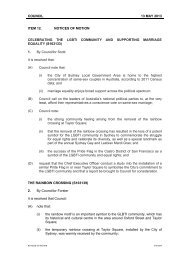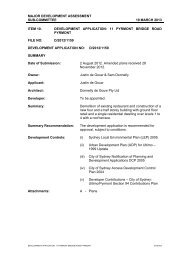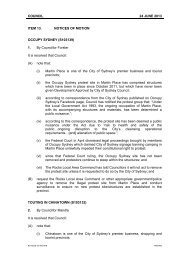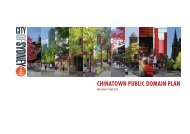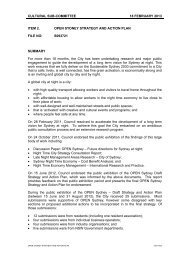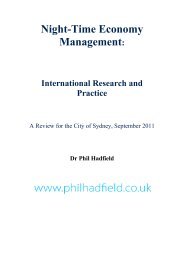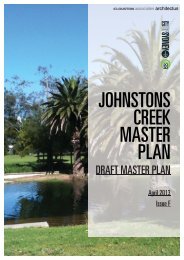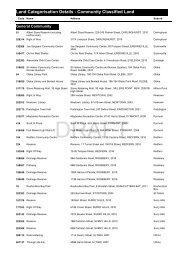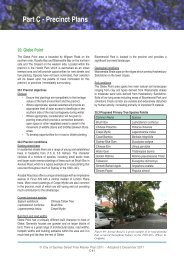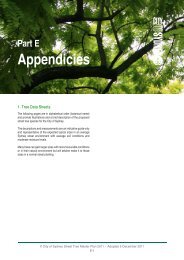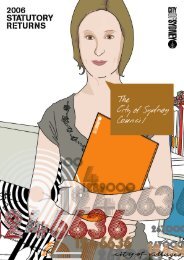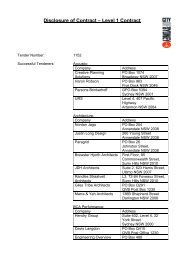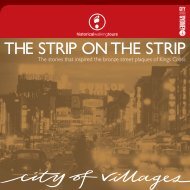Histories of Green Square - City of Sydney
Histories of Green Square - City of Sydney
Histories of Green Square - City of Sydney
You also want an ePaper? Increase the reach of your titles
YUMPU automatically turns print PDFs into web optimized ePapers that Google loves.
<strong>Histories</strong> <strong>of</strong> <strong>Green</strong> <strong>Square</strong><br />
At first the state’s Baby Health clinics program came under<br />
strong attack from doctors, especially in the new area <strong>of</strong> paediatrics.<br />
They became more supportive <strong>of</strong> the movement as they<br />
saw new career opportunities opening for them. Women’s and<br />
feminist groups also attempted to influence policy outcomes,<br />
but did not have the political clout <strong>of</strong> the doctors. More<br />
research is needed on their involvement in this process, and<br />
also on women’s other roles. Women were not just clients <strong>of</strong><br />
the baby health centres. As feminists, doctors and philanthropists,<br />
they were themselves involved in framing infant health<br />
and welfare policy.<br />
In 1926 the Department <strong>of</strong> Pubic Health took over the baby<br />
health centres, and this marked an end to the focus on working<br />
class women alone. The baby health centres became a service<br />
that was universally accessible to all mothers, regardless <strong>of</strong> class<br />
background. The infant welfare movement was now under the<br />
direction <strong>of</strong> a newly emerged class <strong>of</strong> experts: nurses, doctors<br />
and clinic sisters who believed that all women needed to be<br />
taught mothercraft, not just working class mothers. They<br />
urged women to avoid the traditional child-rearing practices<br />
passed on to them from their own mothers, and to follow<br />
instead only expert advice that was grounded in ‘scientific’<br />
evidence. Thus the baby health movement can be seen as a part<br />
<strong>of</strong> the road to modernisation. The nurses, doctors and sisters<br />
were part <strong>of</strong> the much broader national efficiency movement<br />
which held an ambitious vision for a new society, where social<br />
harmony could be achieved by a state bureaucracy applying<br />
scientific principles to social problems or conflicts.<br />
What is missing from this story is the voices <strong>of</strong> the mothers<br />
<strong>of</strong> Alexandria and other <strong>Green</strong> <strong>Square</strong> suburbs themselves.<br />
They were not just passive recipients, they had to make choices<br />
about what service they used, whether they would follow the<br />
advice, or whether they would even use the baby health centre<br />
in the first place. For these reasons, an oral history <strong>of</strong> the<br />
women who lived in the <strong>Green</strong> <strong>Square</strong> area would be a very<br />
valuable and rewarding project.<br />
2.10 Exodus and Retreat:<br />
The Chinese <strong>of</strong> Alexandria and Waterloo<br />
Melita Rogowsky<br />
The Retreat Street precinct <strong>of</strong> Alexandria is associated with<br />
successive waves <strong>of</strong> Chinese immigration to Australia. The<br />
area surrounding Retreat Street in Alexandria and Waterloo<br />
has been the site <strong>of</strong> continuous Chinese occupation since at<br />
least the 1870s. Though the numbers <strong>of</strong> Chinese in the area<br />
fluctuated dramatically with the introduction and intensification<br />
<strong>of</strong> the White Australia Policy (WAP), the precinct<br />
accommodated the highest concentration <strong>of</strong> Chinese market<br />
gardeners in <strong>Sydney</strong> during the 1880s and early 1900s. The<br />
swamplands <strong>of</strong> Waterloo provided fertile ground for the<br />
gardens and the gardeners lived in wooden huts adjacent to<br />
the street (which have since been destroyed by fire and/or government<br />
‘cleansing’). They spent their recreational time, along<br />
with other working class Chinese (as well as Europeans), in<br />
Retreat Street, which was notorious for its gambling houses.<br />
The surrounding area, particularly Botany Road and Bourke<br />
Street, hosted many other successful Chinese businesses,<br />
including more market gardeners, grocers, cabinetmakers and<br />
a butcher. The state heritage listed Yiu Ming Temple (circa<br />
1909) and the locally listed terrace houses which adjoin it, were<br />
built by local tradesmen <strong>of</strong> the Go Yui clan. Situated at the far<br />
end <strong>of</strong> Retreat Street, they are associated with many <strong>of</strong> the his-<br />
20<br />
torical figures and businesses <strong>of</strong> the area and remain a key site<br />
<strong>of</strong> religious and cultural activity for the Go Yui clan. Australian<br />
Born Chinese (ABC) children who were born and raised<br />
in this region attended the local Waterloo Public School. The<br />
conflicts between European-Australians and Chinese-Australians<br />
and the resultant oppressive legislation and regulation<br />
were played out in community agitation and action, media<br />
propaganda, harassment and violence. One important lesson<br />
is that racism does not appear to have been a constant factor<br />
at this local level, but rather escalated in the late nineteenth<br />
and early twentieth centuries; but even then it was at times<br />
mitigated by instances <strong>of</strong> sympathy, friendship and esteem.<br />
The combined districts <strong>of</strong> Alexandria and Waterloo are thus<br />
places <strong>of</strong> special cultural significance and meaning for people<br />
with links to the Chinese communities <strong>of</strong> this neighbourhood<br />
today. They also enrich our understanding <strong>of</strong> <strong>Sydney</strong>’s multicultural<br />
past. It is an important reminder to future generations<br />
<strong>of</strong> Australians <strong>of</strong> the broad and complex history <strong>of</strong> urban<br />
Chinese settlement outside <strong>of</strong> the boundaries <strong>of</strong> the area now<br />
commonly known as ‘Chinatown’. It is a story which tells us<br />
about the local implementation <strong>of</strong> the WAP, and Chinese<br />
community resistance to and negotiation with the xenophobic<br />
Australia <strong>of</strong> the nineteenth and twentieth centuries.<br />
Making this history available to Chinese communities in this<br />
region and elsewhere, new and current residents <strong>of</strong> the area,<br />
schools, libraries and workplaces, will contribute to a richer<br />
understanding <strong>of</strong> an area that is <strong>of</strong>ten wrongly dismissed as an<br />
industrial wasteland.<br />
As Ann Stephen noted in her report Lions <strong>of</strong> Retreat Street,<br />
Chinese settlement in Retreat Street has in part reshaped the<br />
meaning <strong>of</strong> Alexandria and Waterloo. These suburbs were<br />
named to celebrate the recent victory <strong>of</strong> the British in the<br />
Napoleonic Wars, as was Retreat Street, which takes its name<br />
from the Waterloo Retreat Hotel which once stood on its<br />
corner. But Retreat Street has become synonymous with the<br />
tranquillity <strong>of</strong> the temple, rather than with a working class<br />
pub, or European battles.<br />
2.11 From German Streets to Russian libraries:<br />
Immigrant <strong>Histories</strong> <strong>of</strong> <strong>Green</strong> <strong>Square</strong><br />
Susan O’Reilly<br />
The <strong>Green</strong> <strong>Square</strong> area is known for its industrial history,<br />
plants, factories and most recently for the development <strong>of</strong><br />
expensive high-density housing. But these areas were not<br />
spaces only <strong>of</strong> economic development, devoid <strong>of</strong> human<br />
voices and the stories <strong>of</strong> the surrounding communities. What<br />
accents did these voices have? What cultures wove amongst<br />
one another, creating the diverse religious and ethnic communities<br />
that exist in the area today?<br />
The <strong>Green</strong> <strong>Square</strong> area has attracted immigrants ever since<br />
industries were established here, and continues to do so. This<br />
history has not yet been written and records are scant, yet a<br />
wealth <strong>of</strong> immigration stories were found. The area has been<br />
home to an incredibly diverse range <strong>of</strong> ethnic groups, from the<br />
early Irish, to the Greek, Italian, and eastern European communities<br />
<strong>of</strong> the post-war period. There was also a strong Chinese<br />
presence, and later other Asian communities, including the<br />
Vietnamese. The pattern <strong>of</strong> immigrants settling in the area<br />
to take advantage <strong>of</strong> the high levels <strong>of</strong> unskilled employment<br />
has been a constant feature <strong>of</strong> the area, from Irish in the mid<br />
nineteenth century, to the Ukrainian, Vietnamese and Chinese<br />
people in the area today. Immigrants have therefore been<br />
integral to the area’s industrial and labour history. They were<br />
among the hundreds or thousands <strong>of</strong> workers in the major<br />
industries, and became shopkeepers, tradesmen and market<br />
gardeners.<br />
Little social infrastructure was available for the first waves<br />
<strong>of</strong> immigrants. The support and security networks were<br />
fulfilled mainly by religious orders, church communities and<br />
their affiliated organisations. Family and local community<br />
networks were also established. Religious diversification and<br />
commitment was strong, with the establishment <strong>of</strong> the first<br />
Maronite and Melkite churches (1894 and 1895 respectively)<br />
in Waterloo, which reflected a strong Syrian and Lebanese<br />
population. Mt Carmel Catholic Church, built in 1859, was the<br />
pride <strong>of</strong> the Irish community but also ministered to Maltese<br />
and Lebanese Catholics in the twentieth century.<br />
Local government programs and services to assist migrants<br />
have only developed strongly during the 1990s, and they<br />
have clearly increased immigrants’ opportunities and desire<br />
to interact more closely with the wider community. Their<br />
success, compared with the lack <strong>of</strong> established services in the<br />
earlier periods, makes it poignantly obvious how hard interaction<br />
would have been for the area’s immigrants from the late<br />
1800’s to the late nineties.<br />
There are no extraordinary immigration stories amongst<br />
these histories, so far. Little scandal and very few controversial<br />
issues seem to have arisen. What is important is the remarkable<br />
ability <strong>of</strong> these immigrant groups to establish functioning<br />
and resourceful communities that did not forget their traditions<br />
and cultures but also eventually incorporated them into<br />
the wider community <strong>of</strong> the area.<br />
2.12 The Roots <strong>of</strong> <strong>Green</strong> <strong>Square</strong>: A Planning History<br />
Tessa Endelman<br />
<strong>Green</strong> <strong>Square</strong> area has long been a site for planning visions.<br />
Over the twentieth century there were various schemes for the<br />
redevelopment <strong>of</strong> certain aspects, areas and services in South<br />
<strong>Sydney</strong>, so the current plans for <strong>Green</strong> <strong>Square</strong> are only the latest<br />
in a long history <strong>of</strong> proposed schemes for the area. Despite its<br />
long history <strong>of</strong> occupation, very little in the way <strong>of</strong> planned<br />
redevelopment was actually achieved. At times administered<br />
by individual local councils, for most <strong>of</strong> its recent history the<br />
majority <strong>of</strong> the district has been governed alternately by either<br />
South <strong>Sydney</strong> Council or the <strong>City</strong> <strong>of</strong> <strong>Sydney</strong> Council.<br />
The <strong>Green</strong> <strong>Square</strong> project was primarily created through an<br />
alliance between South <strong>Sydney</strong> <strong>City</strong> Council and the NSW<br />
State Government. Since about 1991, discussions between<br />
community groups and planners have been held through<br />
a wide variety <strong>of</strong> forums. Community consultation was a<br />
fundamental part <strong>of</strong> the new development scheme, and was<br />
achieved through the circulation <strong>of</strong> a discussion paper, various<br />
discussion groups, letter drops and surveys as well as through<br />
regular updates in the community newsletter the Inner-city<br />
News.<br />
An important factor in the projected urban renewal is the<br />
rezoning <strong>of</strong> activities within the area. <strong>Green</strong> <strong>Square</strong> has a long<br />
industrial history and much <strong>of</strong> it was previously known as<br />
a slum area. Industrial expansion in the post-WWII period<br />
further reduced the quantity <strong>of</strong> housing and the quality <strong>of</strong> the<br />
urban environment. One <strong>of</strong> the key objectives <strong>of</strong> the <strong>Green</strong><br />
<strong>Square</strong> project is to encourage multi-land use in the area,<br />
increasing the balance <strong>of</strong> industrial with commercial and residential<br />
areas.<br />
Chapter 2 – Snapshots: <strong>Green</strong> <strong>Square</strong> <strong>Histories</strong> in Brief<br />
The community’s response revealed the major concerns to be<br />
the environment, the future role <strong>of</strong> the city, transport, public<br />
safety and the needs <strong>of</strong> the community. Bearing this in mind,<br />
the council’s development consultants created the South<br />
<strong>Sydney</strong> Plan, part <strong>of</strong> which, the Strategy for a Sustainable<br />
<strong>City</strong> <strong>of</strong> South <strong>Sydney</strong>, incorporates the <strong>Green</strong> <strong>Square</strong> project.<br />
Other major concerns were the maintenance <strong>of</strong> a socially and<br />
culturally diverse population (to be achieved by a percentage<br />
<strong>of</strong> low-cost housing and other strategies), and the promotion<br />
<strong>of</strong> high quality urban design in new development.<br />
Further development in the area was prompted by the State<br />
Government’s announcement <strong>of</strong> the new Southern Railway,<br />
a service that would run between the airport and Central<br />
Station for the millions <strong>of</strong> visitors expected during the 2000<br />
<strong>Sydney</strong> Olympic Games. The plan <strong>of</strong> the new train line<br />
included a new station situated in the heart <strong>of</strong> a newly defined<br />
<strong>Green</strong> <strong>Square</strong> area. Access to rail transport finally sparked the<br />
total redevelopment <strong>of</strong> the area. By 1997, a draft Masterplan<br />
had been developed by South <strong>Sydney</strong> Council’s consultants,<br />
Stanisic Turner, in association with Hassell Pty Ltd. It aimed to<br />
convert the largely industrial pr<strong>of</strong>ile <strong>of</strong> the area into residential<br />
and mixed land use areas., outlining the future planning <strong>of</strong><br />
<strong>Green</strong> <strong>Square</strong> and its development into the year 2020.<br />
To date, the <strong>Green</strong> <strong>Square</strong> project has faced several difficulties<br />
and has become further and further removed from the original<br />
plans and their underlying philosophies. It will be interesting<br />
to see whether it will achieve the high levels <strong>of</strong> success<br />
in environmental sustainability, social and cultural diversity,<br />
mixed-use zoning, good design and a vibrant urban culture to<br />
which it originally aspired, or whether it will become a ‘white<br />
elephant’. It remains to be seen whether this latest and most<br />
ambitious plan for renewal will suffer a similar fate to that <strong>of</strong><br />
its predecessors, or whether it will achieve an equitable and<br />
sound urban future.<br />
21



